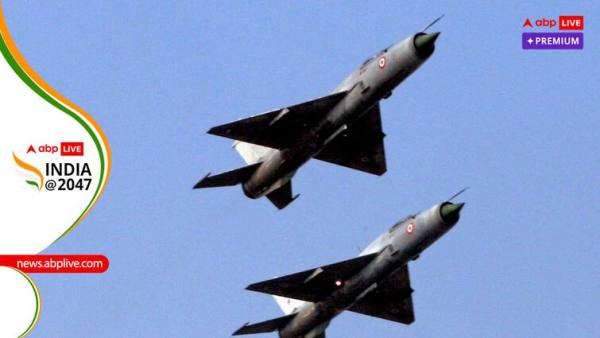
The MiG-21, a distinguished fighter aircraft, has played a pivotal role in ushering the Indian Air Force (IAF) into the supersonic era, serving the nation with honour across multiple conflicts, particularly against Pakistan since 1965. After an impressive 62 years of dedicated service, the last two remaining squadrons of this iconic aircraft are now approaching their retirement.
Acquired in the early 1960s in the wake of the 1962 Sino-Indian War, the MiG-21 was hailed as one of the most advanced and formidable aircraft of its time. Its introduction provided the Indian military with much-needed strategic capabilities, especially following the significant setbacks experienced during the conflict with China.
From 1965 To 1971: Becoming The Backbone Of IAF
While the MiG-21 had a limited operational role in the 1965 war, it emerged as a cornerstone of the IAF during the 1971 conflict with Pakistan, where its combat capabilities were crucial to the Indian military's success. The aircraft's impressive Mach-2 speed allowed IAF pilots to transition smoothly into the supersonic age, paving the way for the later induction of advanced aircraft such as the Jaguar and Mirage 2000 in the early 1980s.
Although the IAF subsequently acquired more sophisticated variants of the MiG family, including the MiG-23, MiG-27, and MiG-29, the MiG-21 remained a reliable asset, particularly in air defence roles.
Post-Balakot: A Symbol of Pride And Combat Relevance
The MiG-21's legacy was further solidified during the post-Balakot surgical strike in 2019, when it demonstrated its effectiveness against the Pakistan Air Force. The nation erupted in celebration when a MiG-21 Bison successfully engaged and downed a U.S.-made F-16 aircraft in the aftermath of Pakistan's retaliatory actions.
This incident not only highlighted the aircraft's enduring combat capabilities but also reinforced its status as a symbol of national pride and resilience.
Training Generations Of Supersonic Warriors
The MiG-21 aircraft has played a pivotal role in shaping three generations of supersonic air warriors, equipping them with the skills necessary for modern aerial combat. Despite its reputation as the "flying coffin," this characterisation does not reflect the aircraft's inherent design flaws but rather the circumstances surrounding its prolonged use.
The Indian Air Force operated these ageing MiG-21s for over sixty years, a model originally conceived in the late 1950s by Soviet engineers.
A Legacy Backed By Indo-Soviet Cooperation
By the late 1990s, a total of 872 MiG-21s had been inducted into the IAF, underscoring the aircraft's extensive service life. The Soviet Union's generous support in facilitating the production of these fighters not only bolstered India's self-reliance in military aviation but also provided the IAF with a significant advantage over neighbouring countries, which possessed less advanced aircraft.
The strategic partnership between India and the Soviet Union during the Cold War was instrumental in enhancing the IAF's capabilities.
MiG-21: A Deterrent Against Both Pakistan And China
This collaboration allowed India to develop a formidable air force, instilling confidence in Indian strategic planners to effectively counter potential adversaries. The MiG-21's firepower was so formidable that it deterred China from escalating tensions following various skirmishes, particularly during the 1967 conflict when the People's Liberation Army faced a significant defeat and retreated from the Sikkim border.
However, the IAF's reliance on this Soviet-designed aircraft persisted for decades, as the indigenous Light Combat Aircraft (LCA) was delayed in its production.
Delayed Replacements And Dependence On Foreign Technology
While the LCA, equipped with an American engine, has recently begun to enter service, India remains critically dependent on the United States for fourth-generation aircraft. Discussions about acquiring fifth-generation fighters are ongoing, yet the indigenously designed Advanced Medium Combat Aircraft (AMCA) is still a decade away from realisation.
The government's initiative to replace the ageing MiG-21 aircraft with the domestically produced Light Combat Aircraft (LCA) faced significant hurdles due to both strategic and technological obstacles.
MiG-21 Bison: A Stopgap That Stayed Too Long
As a result, the Indian Air Force continued to operate the MiG-21s, albeit with some minor upgrades to enhance their capabilities. The most recent iteration, known as the MiG-21 Bison, was developed by converting five squadrons from the earlier MiG-Bis models.
Despite the expectation that the operational lifespan of fighter jets should ideally not exceed twenty-five years, even with mid-life upgrades, the IAF remained reliant on the MiG-21s due to the lack of viable alternatives.
Pilot Training And Safety Challenges
A considerable number of accidents involving the MiG-21s can be attributed to the aircraft's high-speed characteristics during take-off and landing. Indian pilots, unfortunately, did not receive adequate training for the second stage of their flight training, which is now being conducted on British Hawks.
The MiG-21's steep ascent and descent rates posed challenges that were not effectively addressed in pilot training.
Combat Role Declines As Modern Jets Take Over
Following the introduction of advanced aircraft such as the Mirage 2000 and Jaguars in the early to mid-1980s, along with the Sukhoi-30s at the beginning of the 21st century, the role of the MiG-21s shifted primarily to air defence.
Retirement Of MiG-21s Leaves A Void In IAF Strength
The impending retirement of the last two squadrons of 36 MiG-21 Bisons stationed at Nal Air Base in Rajasthan poses a significant challenge to the Indian Air Force (IAF). With no concrete plans for immediate replacement, this transition will result in a substantial reduction in the IAF's combat capabilities.
A long-standing recommendation from a Parliamentary Committee on Defence, which has been in place for over twenty-five years, stipulates that the IAF should maintain a minimum of 42 squadrons.
IAF Faces Critical Shortfall In Air Power
However, the current strength will dwindle to just 29 squadrons following the retirement of the remaining MiG-21 units in September, highlighting a critical shortfall in operational readiness.
The situation is exacerbated by the fact that the IAF has been operating the MiG-21s well beyond their intended service life, leading to a higher rate of aircraft retirement compared to the induction of new models.
Urgent Need for Emergency Acquisition Programme
This imbalance raises serious concerns for both the IAF and India's strategic planners, especially in light of the country's potential two-front war scenario. Such a situation necessitates a robust air force equipped with a greater number of squadrons than the already recommended strength of 42.
The urgent need for the IAF to replace the retired MiG-21s with over 15 squadrons of modern fighter aircraft cannot be overstated.
Strategic Challenge
Moreover, the delayed phasing out of the MiG-21s, coupled with the absence of a comprehensive induction plan, underscores the necessity for an emergency acquisition program to address this critical gap. This issue should not be perceived merely as a logistical challenge for air warriors; rather, it is an urgent strategic requirement for the Indian Air Force and the nation as a whole.
The ability to maintain air superiority is paramount, and without timely action to bolster the IAF's capabilities, India risks compromising its defence posture in an increasingly complex geopolitical landscape.
(The writer is a senior journalist and strategic affairs analyst.)
-
For denying two tickets, England paid heavy price and lost its power to India

-
Photos: Gill, Rahul resist England bowlers to take India to 174/2 on Day 4

-
Before Wonder Woman, Gal Gadot lost to this Bollywood actress

-
From Saiyaara to Awarapan: Is Mohit Suri Bollywood’s K-remake king?

-
Will The Weather Save England Or Haunt India? Manchester Forecast Raises Stakes
